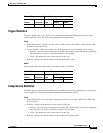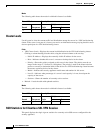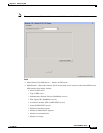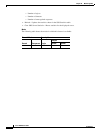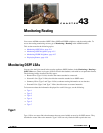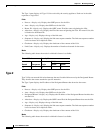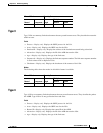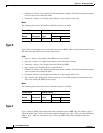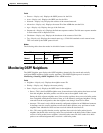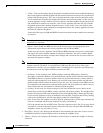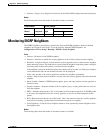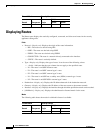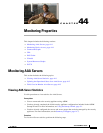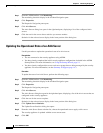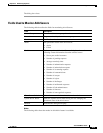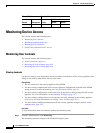
43-5
Cisco ASDM User Guide
OL-16647-01
Chapter 43 Monitoring Routing
Monitoring OSPF Neighbors
Fields
• Process—Display only. Displays the OSPF process for the LSA.
• Area—Display only. Displays the OSPF area for the LSA.
• Network—Display only. Displays the address of the external network.
• Advertiser—Display only. Displays the router ID of the ASBR that sent the LSA.
• Age—Display only. Displays the age of the link state.
• Sequence #—Display only. Displays the link state sequence number. The link state sequence number
is used to detect old or duplicate LSAs.
• Checksum—Display only. Displays the checksum of the contents of the LSA.
• Tag—Display only. Displays the external route tag, a 32-bit field attached to each external route.
This is not used by the OSPF protocol itself.
Modes
The following table shows the modes in which this feature is available:
Monitoring OSPF Neighbors
The OSPF Neighbor pane displays the OSPF neighbors dynamically discovered and statically
configured OSPF neighbors on the security appliance. The OSPF Neighbor pane is located at
Monitoring > Routing >OSPF Neighbors in the ASDM interface.
Fields
• Neighbor—Display only. Displays the neighbor router ID.
• Priority—Display only. Displays the router priority.
• State—Display only. Displays the OSPF state for the neighbor:
–
Down—This is the first OSPF neighbor state. It means that no hello packets have been received
from this neighbor, but hello packets can still be sent to the neighbor in this state.
During the fully adjacent neighbor state, if the security appliance does not receive hello packet
from a neighbor within the dead interval time, or if the manually configured neighbor is being
removed from the configuration, then the neighbor state changes from Full to Down.
–
Attempt—This state is only valid for manually configured neighbors in an NBMA environment.
In Attempt state, the security appliance sends unicast hello packets every poll interval to the
neighbor from which hellos have not been received within the dead interval.
–
Init—This state specifies that the security appliance has received a hello packet from its
neighbor, but the ID of the receiving router was not included in the hello packet. When a router
receives a hello packet from a neighbor, it should list the router ID of the sender in its hello
packet as an acknowledgment that it received a valid hello packet.
Firewall Mode Security Context
Routed Transparent Single
Multiple
Context System
• — • ——



